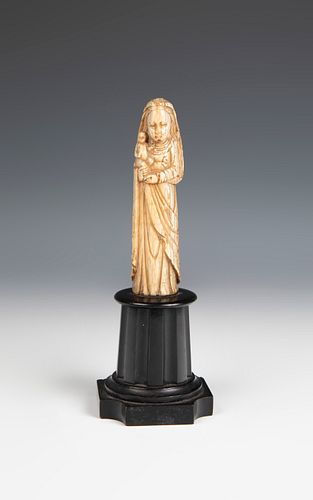Indo-Portuguese school, ca.1600. "Virgin and Child. Carved ivory. Rear pedestal. Measurements: 12 cm high figure; 7.5 cm high pedestal.
Lot 137
About Seller
Setdart Auction House
Carrer Aragó 346
Barcelona
Spain
Setdart Subastas was born in 2004 and is currently the first online art auction in Spain with solidity, prestige and reliability guaranteed by our more than 60,000 users. Setdart has a young, dynamic and enterprising team ready to successfully manage the purchase and sale of art works through custom...Read more
Estimate:
EUR€700 - EUR€900
$736.84 - $947.37
Absentee vs Live bid
Two ways to bid:
- Leave a max absentee bid and the platform will bid on your behalf up to your maximum bid during the live auction.
- Bid live during the auction and your bids will be submitted real-time to the auctioneer.
Bid Increments
| Price | Bid Increment |
|---|---|
| EUR€0 | EUR€10 |
| EUR€200 | EUR€25 |
| EUR€500 | EUR€50 |
| EUR€1,000 | EUR€100 |
| EUR€3,000 | EUR€200 |
| EUR€5,000 | EUR€500 |
| EUR€10,000 | EUR€1,000 |
| EUR€20,000 | EUR€2,000 |
| EUR€50,000 | EUR€5,000 |
About Auction
By Setdart Auction House
Oct 20, 2021
Set Reminder
2021-10-20 07:30:00
2021-10-20 07:30:00
America/New_York
Bidsquare
Bidsquare : OLD MASTERS
https://www.bidsquare.com/auctions/setdart-auction-house/old-masters-7700
Setdart Auction House sofia@setdart.com
Setdart Auction House sofia@setdart.com
- Lot Description
Indo-Portuguese school, ca.1600. "Virgin and Child. Carved ivory. Rear pedestal. Measurements: 12 cm high figure; 7.5 cm high pedestal. Carved ivory sculpture. The characteristic way of carving the hair of the Indo-Portuguese school can be seen, consisting of making curls with symmetrical incisions marking the direction of the hair. Also typical of this school are the straight nose and the closed mouth with barely marked lips, as well as the almond-shaped eyes, which are clearly oriental. The trade routes linking Europe, America and the Indies brought various oriental products to the Iberian Peninsula, most of which were considered luxury items, including pieces made of ivory. Royal families, nobility and people of high social standing all desired exotic objects for their collections, and ivory carvings were among the most prized, both for the value and exoticism of the material itself and for the quality of the workmanship. These carvings also had a dual function. Firstly, they were precious and decorative objects, but they also had a didactic and evangelistic purpose, as carvings were made with Christian themes and iconography, using decorative motifs, elements and techniques typical of the Far East. Generally speaking, the missionaries commissioned local artists to make them, showing them European models to imitate. These types of pieces, intended for Portuguese clients, were made especially in Goa (India), which was also an important centre of furniture manufacture. The artists in that area had a long tradition of ivory sculpture, so the result was a synthesis of the local aesthetic heritage (emphasis on the textures of clothing and objects, the importance of animalistic representation, etc.), with Western iconography and taste.
- Shipping Info
-
In-house shipping available. Please inquire at admin@setdart.com.
-
- Buyer's Premium



 EUR
EUR CAD
CAD AUD
AUD GBP
GBP MXN
MXN HKD
HKD CNY
CNY MYR
MYR SEK
SEK SGD
SGD CHF
CHF THB
THB






